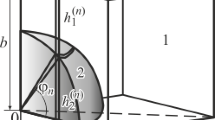The effects of orientation and shape of filler particles on the elastic properties of composites have been analyzed. The elastic constants of a composite with irregularly oriented filler particles were calculated by using the method of orientational averaging of the properties of a representative structural element. The elastic constants of the structural element were found according to a known generalized Eshelby solution for a finite concentration of ellipsoidal inclusions. The diagrams of elasticity anisotropy for a transversely isotropic structural element and an orthotropic composite with irregularly oriented inclusions are presented. A quantitative estimate for the degree of anisotropy of elastic properties of composites is suggested. Data on the influence of shape anisometry of inclusions on the anisotropy coefficient of filled composites are also reported.
Similar content being viewed by others
References
A. Lagzdins, R. D. Maksimov, and E. Plume, “Elasticity of composites with irregularly oriented shape-anisotropic filler particles,” Mech. Compos. Mater., 42, No. 3, 197–208 (2006).
E. Plume, R. D. Maksimov, and A. Lagzdins, “Effect of anisometry of a plate like nanofiller on the elastic constants of a transversely isotropic composite,” Mech. Compos. Mater., 44, No. 4, 341–348 (2008).
S. W. Tsai and N. J. Pagano, “Invariant properties of composite materials,” in: S. W. Tsai, J. C. Halpin, and N. J. Pagano (eds.), Composite Materials Work shop, Technomic Publishing Co., Stamford, Conn. (1968), p. 233.
J. C. Halpin, “Stiffness and expansion estimates for oriented short fiber composites,” J. Compos. Mater., 3, 732–734 (1969).
J. C. Halpin and N. J. Pagano, “The laminate approximation for randomly oriented fibrous composites,” J. Compos. Mater., 3, 720–724 (1969).
J. D. Eshelby, “The determination of the elastic field of an ellipsoidal inclusion, and related problems,” Proc. Roy. Soc. Ser. A, 241, 376–396 (1957).
T. Mori and K. Tanaka, “Average stress in matrix and average elastic energy of materials with misfitting inclusions,” Acta Metall., 21, No. 5, 571–574 (1973).
T. S. Chow, “Effect of particle shape at finite concentration on the elastic moduli of filled polymers,” J. Polym. Sci. Polym. Phys. Ed., 16, No. 6, 959–965 (1978).
G. P. Tandon and G. J. Weng, “The effect of aspect ratio of inclusions on the elastic properties of unidirectionally aligned composites,” Polym. Compos., 5, No. 4, 327–333 (1984).
G. P. Tandon and G. J. Weng, “Average stress in the matrix and effective moduli of randomly oriented composites,” Compos. Sci. Technol., 27, 111–132 (1986).
T. D. Shermergor, Theory of Elasticity of Microinhomogeneous Media [in Russian], Nauka, Moscow (1977).
R. M. Christensen, Mechanics of Composite Materials, John Wiley & Sons, New York–Chichester–Brisbane–Toronto (1979).
H. Tan, Y. Huang, C. Liu, and P. H. Geubelle, “The Mori–Tanaka method for composite materials with nonlinear interface debonding,” Int. J. Plast., 21, 1890–1918 (2005).
N. Sheng, M. C. Boyce, D. M. Parks, G. C. Rutledge, J. I. Abes, and R. E. Cohen, “Multiscale micromechanical modeling of polymer/clay nanocomposites and the effective clay particle,” Polymer, 45, 487-506 (2004).
G. M. Odegard, T. C. Clancy, and T. S. Gates, “Modeling of the mechanical properties of nanoparticle/polymer composites,” Polymer, 46, 553–562 (2005).
Y. Benveniste, “A new approach to the application of Mori–Tanaka’s theory in composite materials,” Mech. Mater., 6, 147–157 (1987).
L. H. Dai, Z. P. Huang, and R. A. Wang, “Generalized self-consis tent Mori–Tanaka scheme for prediction of the effective elastic moduli of hybrid multiphase particulate composites,” Polym. Compos., 19, No. 5, 506–513 (1998).
E. Jao Jules, T. Tsujikami, S. V. Lomov, and I. Verpoest, “Effect of fibre length and fibre orientation on the predicted elastic properties of long-fibre composites,” Macromol. Symp., 17.08.2004.
S. G. Lekhnitskii, Elasticity Theory of Anisotropic Bodies [in Russian], Nauka, Moscow (1977).
A. F. Zilauts and A. F. Kreger, “Deformation surfaces of a composite material,” Mekh. Polim., No. 6, 975–981 (1976).
A. F. Kreger and A. F. Zilauts, “Numerical characteristics of the degree of anisotropy of the mechanical properties of materials,” Mekh. Polim., No. 4, 601–609 (1978).
Author information
Authors and Affiliations
Additional information
Translated from Mekhanika Kompozitnykh Materialov, Vol. 45, No. 4, pp. 507–524, July–August, 2009.
Rights and permissions
About this article
Cite this article
Lagzdins, A., Maksimov, R.D. & Plume, E. Anisotropy of elasticity of a composite with irregularly oriented anisometric filler particles. Mech Compos Mater 45, 345–358 (2009). https://doi.org/10.1007/s11029-009-9096-3
Received:
Published:
Issue Date:
DOI: https://doi.org/10.1007/s11029-009-9096-3




